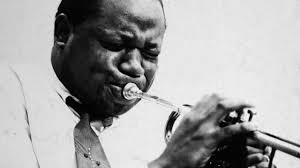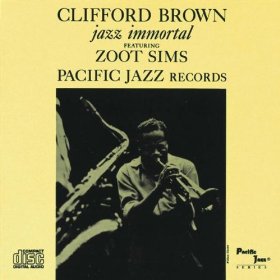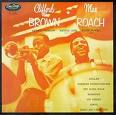Joy Spring – Clifford Brown
Lead sheets from the both the concert E-flat septet version and the standard key, F (quintet version). Plus explore Clifford Brown's solos on his classic masterpiece from the septet and quintet recordings! Solos in B-flat and C editions.
- Recording: Clifford Brown featuring Zoot Sims - Jazz Immortal
- Recorded on: July 12, 1954
- Label: Capitol (CDP 7 46850 2)
- Concert Key: E-flat
- Vocal Range: , to
- Style: Swing (medium)
- Trumpet - Clifford Brown
- Valve Trombone - Stu Williamson
- Tenor Sax - Zoot Sims
- Bari Sax - Bob Gordon
- Piano - Russ Freeman
- Bass - Joe Mondragon
- Drums - Shelly Manne
- Description
- Historical Notes
- Solos
- Piano Corner
- Bass Corner
- Drum Corner
- Guitar Corner
- Inside & Beyond
- Minus You
The Montrose arrangement weaves the melody back and forth between Clifford and the other instruments of the ensemble in some places; this is notated in the septet arrangement (see below for availability). Our E♭ concert lead sheets are not what Clifford plays on this recording, rather, they show the whole melody intact in E♭ concert.
You'll see that you can play the melody of our edition with the recording, and it works great, until you get to the solo break. Montrose added an extension, making what is normally an eight-measure last section into a ten-measure section. For the lead sheets, we've kept the last section to eight measures, Clifford's normal coda.
Don Sickler: "Being able to play and solo fluently in different keys is challenging, fun and very important. I always remember fellow trumpet player Jack Walrath's comment, 'If you really think you have your technique together, try to play Joy Spring through ALL the keys. That will kick your butt!'"
Note: The printed arrangements (quintet and septet) are available from MusicDispatch.com and other music distributors.
First, Clifford recorded Joy Spring on a septet session for Pacific Jazz on July 12, 1954, with arrangements written by Jack Montrose. Then, less than a month later, Clifford, with drummer Max Roach and the rest of the Clifford Brown - Max Roach quintet, started off their August 6, 1954, recording session with two takes of Joy Spring.
Unfortunately, we only have Clifford playing Joy Spring on these two recording sessions, unlike his other "jazz standard" Daahoud, which is on those two sessions, but was also recorded on July 16, 1955; February 26, 1956; May 6, 1956 and June 1, 1956.
Before Clifford recorded with Max Roach, he had to fulfill a commitment he had made to Dick Bock at Pacific Coast Jazz Records. In the spring of 1954, tenor saxophonist Jack Montrose, who Bock chose to write the arrangements for the session, had a group with Art Pepper that played on the same bill at the Tiffany Club opposite Clifford and Max's group. During the days of this engagement, Jack got to spend time with Clifford going over his originals.
Author Nick Catalano has some interesting quotes from Jack about Clifford, in his book "Clifford Brown, The Life and Art of the Legendary Jazz Trumpeter." Discussing the Joy Spring key change:
"Montrose lowered the key to E♭ because he enjoyed Brownie's lower register improvisations. When Brown stepped up to play the arrangement, he was surprised at the key change. Seeing this, Montrose quickly suggested that they record the piece later on, but Brownie said, 'No problem, let's do it in this key,' and that's how the record was made."
Joy Spring is full of movement, both melodically and harmonically. Even if you know the song well in F concert, it can still throw you a loop to suddenly have to play it in a different key.
The printed septet and quintet arrangements are both classic charts, fun to play and always popular with audiences. They've been available from Second Floor Music for a number of years. They're accurate and complete: years ago, arranger Jack Montrose gave SFM a copy of his score from the septet recording session, and Don Sickler transcribed the quintet arrangement so it's complete with introduction, etc.
Click on these links for information about these two print arrangements at http://www.secondfloormusic.com:
Joy Spring - Brown, Clifford - Quintet
Joy Spring - Brown, Clifford - Septet - Arranged by Jack Montrose
To immediately purchase the arrangements from Music Dispatch:
Joy Spring Quintet arrangement (product HL00000550)
Joy Spring Septet arrangement (product HL00000772)
Transcribed Trumpet Solo: Listen to the last measure of the septet arrangement before Clifford's solo break and hear the start of his classic solo in E-flat concert: trumpet
Related Songs
Email Send Joy Spring to a friend
- Recording: Clifford Brown and Max Roach - Clifford Brown And Max Roach
- Recorded on: August 6, 1954
- Label: EmArcy (MG 36036)
- Concert Key: F
- Vocal Range: , to
- Style: Swing (medium)
- Trumpet - Clifford Brown
- Tenor Sax - Harold Land
- Piano - Richie Powell
- Bass - George Morrow
- Drums - Max Roach
- Description
- Historical Notes
- Solos
- Piano Corner
- Bass Corner
- Drum Corner
- Guitar Corner
- Inside & Beyond
- Minus You
Now you can compare this classic version with the previous one (in E♭).
How well do you really know these classic recordings? The new lead sheet in the standard key of F contains the most important rhythm section hits, as well as the coda, which is the same as on the lead sheet in the key of E♭ but was not used for the Pacific Jazz recording.
The most striking difference between this version of Joy Spring and the way in which it is usually played is in the changes of the head. In this respect the Pacific Jazz recording is closer to how the song is typically approached, even though it's in a different key. On the Brown/Roach quintet recording, pianist Richie Powell and bassist George Morrow clearly play G minor, G♯ minor and A minor for the second and third measures, and F major with A in the bass followed by A♭ major 6th in the fifth measure. Also rarely played is the passing A diminished chord between the F minor and B♭7 in the fourth measure of the bridge; this fits with the rhythm section hits, which line up with the melody.
On the solos on this recording, the second and fifth measures of the A and D sections (E and H) are approached in a variety of ways; the C7 in the second measure can be replaced with G♯ diminished, G♯ minor, or B♭7, and the D7 in the fifth measure is sometimes A♭6, A♭7 or G♯ minor.
The intro on this recording is in the quintet arrangement, available from MusicDispatch.com. Transcriptions of Clifford's solos on both the master and alternate takes are available here on jazzleadsheets.com; click on the Solos tab for more details.
Printed combo arrangements (quintet and septet) are available from MusicDispatch.com and other music distributors.
First, Clifford recorded Joy Spring on a septet session for Pacific Jazz on July 12, 1954, with arrangements written by Jack Montrose. Then, less than a month later, Clifford, with Max Roach and the rest of the Clifford Brown - Max Roach quintet, started off their August 6, 1954, recording session with two takes of Joy Spring.
Clifford Brown and Max Roach first recorded together in April of 1954, with Teddy Edwards on tenor sax, Carl Perkins on piano and George Bledsoe on bass. Our group's first recording session was August 2, 1954, where they recorded Sweet Clifford and five other arrangements. On August 5, they were back in the studio recording four more tracks, and on August 6 they started the session with two takes of Joy Spring and ended the session with two takes of Daahoud.
Interestingly, Jack Montrose's septet arrangement is in E-flat concert, instead of F concert, which is the key Clifford used for the quintet recording, so we have the unique opportunity to hear and compare how Clifford solos on his classic composition in two different keys.
The printed septet and quintet arrangements are both classic charts, fun to play and always popular with audiences. They've been available from Second Floor Music for a number of years. They're accurate and complete: years ago, arranger Jack Montrose gave SFM a copy of his score from the septet recording session, and Don Sickler transcribed the quintet arrangement so it's complete with introduction, etc.
Click on these links for information about these two print arrangements at http://www.secondfloormusic.com:
Joy Spring - Brown, Clifford - Quintet (product HL00000550)
Joy Spring - Brown, Clifford - Septet - Arranged by Jack Montrose (product HL00000772)
Click to immediately purchase the arrangements from Music Dispatch:
Joy Spring Quintet arrangement
Joy Spring Septet arrangement
Transcribed Trumpet Solos: As we mentioned, less than a month after the septet recording of Joy Spring (which was in E-flat concert), the Clifford Brown-Max Roach quintet recorded two classic takes of it in F concert. We'll first tease you with an audio clip of how Clifford gets into the bridge of his first chorus of the alternate take, the first take recorded bridge. It's not as widely known as the master take. Sounds great, doesn't it? The second take (or master take), however, yielded probably Clifford's most recognizable solo section at the bridge. Here's how he sets it up bridge2.
Both takes are very important to study, as is Clifford's solo (E-flat concert) on the septet recording, where he takes the solo break and is the first soloist. On the quintet recording, Clifford is the second soloist; Harold Land takes the initial solo break and solos first. Harold hands Clifford his solo choruses in different ways, which makes Clifford answer Harold in two different ways. Here's how Harold sets up the beginnings of Clifford's choruses: alternate take start, master take start2.
These are 3 great solos, well worth a lot of study.
The printed septet and quintet arrangements are both classic charts, fun to play and always popular with audiences. They've been available from Second Floor Music for a number of years. They're accurate and complete: years ago, arranger Jack Montrose gave SFM a copy of his score from the septet recording session, and Don Sickler transcribed the quintet arrangement so it's complete with introduction, etc.
Click on these links for information about these two print arrangements at http://www.secondfloormusic.com:
Joy Spring - Brown, Clifford - Quintet (product HL00000550)
Joy Spring - Brown, Clifford - Septet - Arranged by Jack Montrose (product HL00000772)
Click to immediately purchase the arrangements from Music Dispatch:
Joy Spring Quintet arrangement
Joy Spring Septet arrangement
Related Songs
Email Send Joy Spring to a friend

Clifford Brown
October 30, 1930 – June 27, 1956
Clifford Brown was a legendary and influential trumpet player who had everything going for him: an incredible sound, dazzling technique and ideas, and a great compositional gift. Brown was in the limelight for just five years (he died in a car accident at age 25) yet his mark on jazz is indelible. Early performances at jam sessions with Dizzy Gillespie, Charlie Parker and Fats Navarro (his major influences) led to work with R&B bandleader Chris Powell, which included his first commercial recording (March 21, 1952). His second commercial recording was with Lou Donaldson for Blue Note Records (June 9, 1953), a session that also included Philly Joe Jones and Elmo Hope (Carvin' The Rock, De-Dah and Bellarosa). On this session, Clifford also got to record one of his own compositions (Brownie Speaks), which became his first recorded composition. Read more...





